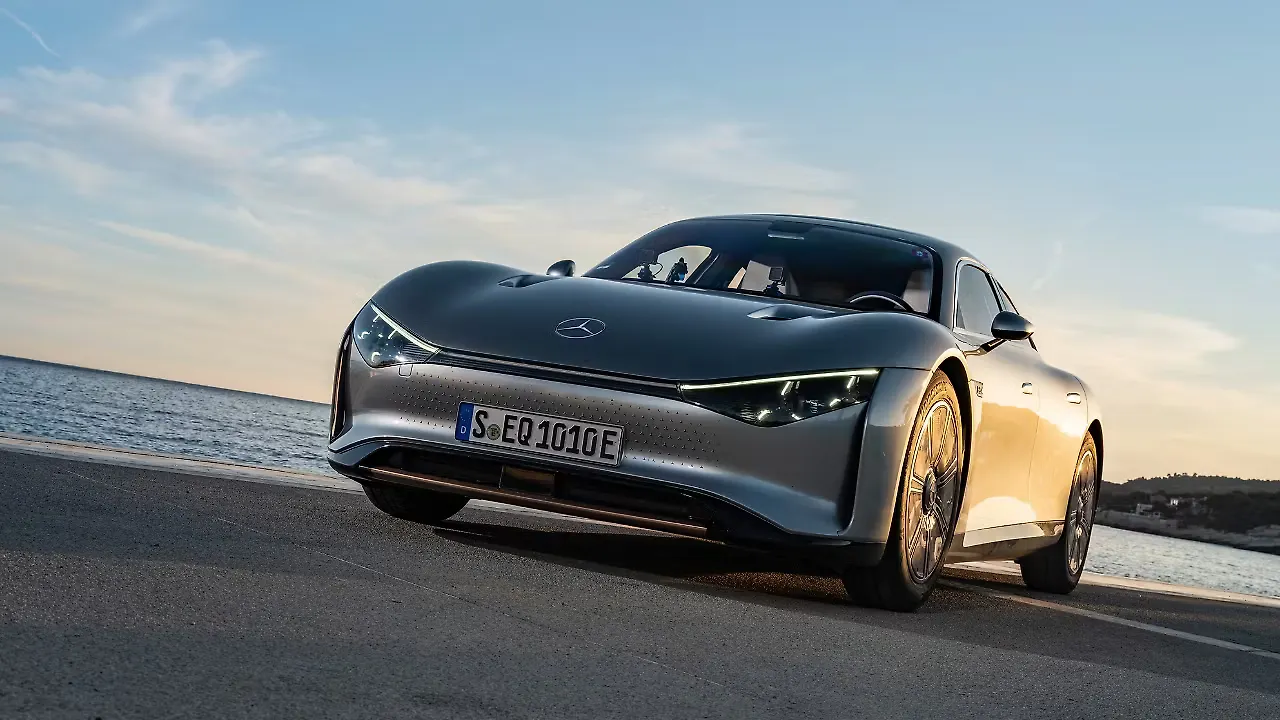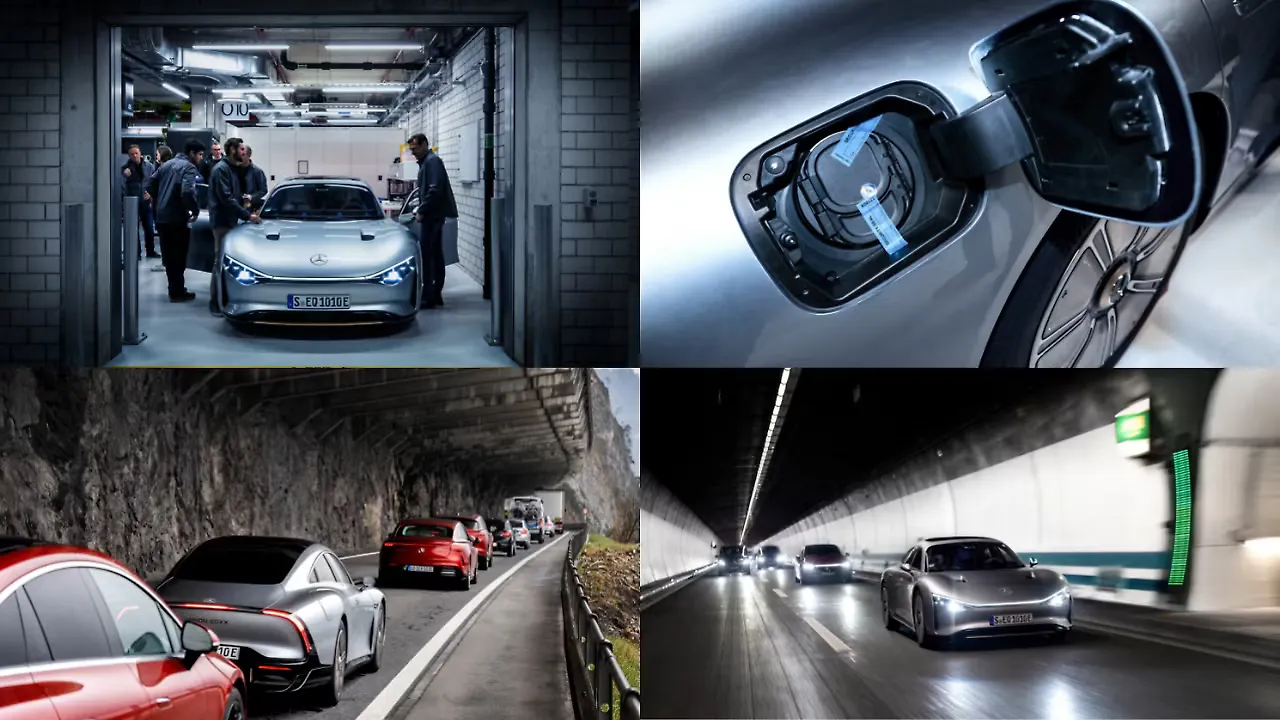
As the competition to build an EV with the longest range intensifies, the German luxury carmaker, Mercedes-Benz, flexing its innovative muscles, showcased the EQXX concept, which is claimed to have a staggering range of 1,000 kms on a single charge.
With a wheelbase smaller than the C-Class, the car’s swept tail design and multiple innovations have helped it manage a drag coefficient of 0.17 cd, which is about 0.03 less than the most slippery production car EQS and the Tesla Model S Plaid.
However, the main ingredient of its super range is its 100kWh battery pack, which is 8kWh less than the EQS but is also 30% lighter than the EQS’ battery pack. The company said that it has drafted the help of engineers from its Formula One team to achieve this feat. Further, the car gets powered by a 204 hp electric motor.
By combining all the factors, the German carmaker has achieved 1000 kms of range on a single charge with the EQXX, or at least this is what they are claiming to have achieved.
To prove this milestone and to show what is electrically ‘feasible,’ the company took the research vehicle on a one-day road trip across several European borders, from Germany to Switzerland, on to Italy, past Milan and finally to its destination, the port town of Cassis near Marseille in the South of France.
The reason to choose this route was that it exposes the car to a variety of challenging courses, ranging from high-speed highways to mountains, and it also exposes the vehicle to temperatures ranging from 3 to 18 degrees Celsius.
First Leg Of Lighting Journey
The first leg of the journey started from the company’s Sindelfingen R&D centre near Stuttgart onto the north-eastern border of Switzerland via the famous Autobahn 81. During its journey at the Autobahn, the car reportedly reached up to 140 kmph and stayed there for quite some time on several occasions.
The car’s aerodynamic shape added to the active rear diffuser, which automatically deploys at 60 km/h, provided better airflow and thus contributed significantly to the reduced drag, the company said.
The technology vehicle gained further efficiency benefits from its tyres, with their extremely low rolling-resistance rating of 4.7. Bridgestone developed these specifically for the car in partnership with Mercedes-Benz.
In comparison, the current EU tyre label requires a figure of 6.5 for the top rating in Class A. However, the EQXX’s tyre dimensions stand at 185/65 R 20 97 T, meaning they have a large diameter and a narrow tread. The specialist, Turanza Eco tyres, combines two innovative Bridgestone technologies that enable a higher range: ENLITEN technology reduces rolling resistance and weight by up to 20%.
Additionally, the ologic technology reduces tyre deformation while driving through a more tensioned belt section. In addition, the transition from the tyre to the wheel rim was optimised in cooperation with the Mercedes-Benz aerodynamics team.

Leg 2: Carving Up The Mountain Tarmac
The second leg of the journey starts with the approach to the Gotthard Tunnel heading for Italy, and the EV’s lightweight body comes into its own play.
On the section between Amsteg and Göschenen, there’s a 14-kilometre uphill stretch with a gradient of up to 5%. It is here where every gram of extra weight eats up energy. However, the VISION EQXX scores sustainable points with its unladen weight of only 1,755 kilograms.
The way the engineers at the company achieved this is by using some clever engineering and materials. It uses carbon-fibre-sugar composite material for the upper part of the battery, which is also used in Formula 1, and the BIONEQXX, while the rear floor is made using an aluminium casting process.
Further, the light metal structural component replaces a much heavier assembly of several interconnected parts. It also has gaps in places where structural strength is not required, thus saving material. This innovative design approach results in a weight saving of up to 20% compared to a conventionally manufactured component.
Mercedes-Benz claims that a large part of the weight efficiency is also due to the dedicated electric chassis with a lightweight F1 subframe, aluminium brake discs, and the battery.
At 100 kWh, it measures 200 x 126 x 11 cm and is also light at 495 kilograms. The electric drive was developed in cooperation with the Mercedes-AMG Petronas F1 Team experts specifically for the vehicle.
Leg 3: Re-energising
After the Gotthard Tunnel, the road goes downhill for a long way. This is where the car makes the most of the situation in its own way, using the regenerative braking system as in every EV.
The company added the concept car could use the recuperation effect on any gradient and during every braking manoeuvre, thus extending its range.
Furthermore, a positive side effect of this electric braking is that the mechanical brakes are barely used.
Leg 4: Powering On The Move
Where regenerative braking is common amongst the EVs, what’s not common is a solar panel. This feature came in handy on the fourth leg of the journey, where the car travelled through the scorched up road of Po Valley near Milan around midday.
Although not for charging the vehicle, the 117 solar cells feed the 12-volt battery that supplies power to auxiliary consumers such as the navigation system.
Overall, the solar booster increases the range by more than 2%, adding up to 25 kilometres on a journey of over 1,000 kilometres.

Additionally, the electric motor, along with the transmission and power electronics developed together with the F1 specialists at HPP, has a peak output of 180 kW and helps the car achieve its claimed 1,000 kms range.
Mercedes added that the electric drive unit is compact, lightweight, and highly efficient, just like the battery. Its average efficiency in this application is 95%.
Furthermore, the engineers at Mercedes-Benz have succeeded in reducing the total losses in the drivetrain, including motor, inverter and transmission, by 44% compared to an e-drive that is not based on this project. This has made a big difference to the bottom line, with 1% more efficiency bringing 2% more range. The battery further amplifies this effect, thanks to its remarkable energy density of almost 400 Wh/l and especially high operating voltage of more than 900 volts.
Besides adding on the efficiency was the cooling underneath the body that uses the airflow to ensure even cooling. This aerodynamically highly efficient solution increases the range by 20 kilometres. The air control system would only open an additional airpath if there was an increased demand for cooling the electric drive or for climate control inside the cabin on hot days or if the heat pump was running on cold days. Also assisting to increase the range was the tech inside that assisted the driver like a co-pilot with tips on the best possible driving style.
The UI/UX features an all-new, one-piece display that spans the entire width of the interior that shows how real-time graphics open up new digital possibilities by reacting instantly to the driver’s needs and bringing the real world into the vehicle. The Artificial Intelligence (AI) inside mimicked the way the human brain works.
Leg 5: Finale In France
After 11 hours and 32 minutes of driving time, the car crossed the finish line in Cassis, covering a total distance of 1,008-kilometre. Interestingly it finished the journey with 15% juice remaining in the battery, enough to go for about 140kms more. This means that it could have set off again for a jaunt along the Mediterranean coastline without recharging!
Conclusion
With this, it seems like Mercedes-Benz will be the first vehicle maker to cross the 1000 kms mark with a production EV. Well, even if the carmaker becomes the first one to produce the first mass-produced EV with a 1000 kms range, it wouldn’t be the EQXX; the company is clear on its stance that the EQXX won’t make it to mass production. However, it will serve as an inspiration for future Mercedes models, both in terms of design and technology.
So it is highly possible that the next generation EVs, rolling out from the assembly line of the Stuttgart based luxury carmaker, may see the semblance or have features carried on from the Vision EQXX.